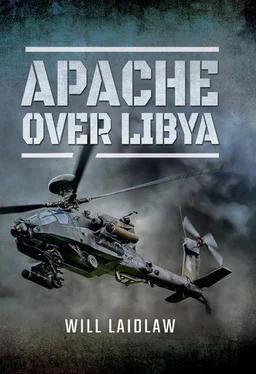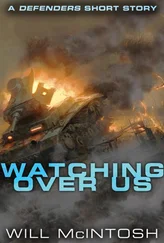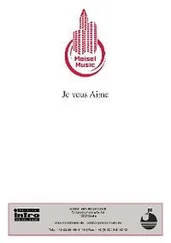Off the coast of Zlitan the maritime patrol aircraft continued its observation. The JTAC was a soldier and he’d spent more than a decade understanding ground in combat, intuitively knowing the difference between normal and hostile. He could see and understand. He hadn’t thrashed past at 500 knots and taken a photograph – a fraction of a second – for someone else to analyse. He was watching, and had been watching for hours. And he was there, in the present. He understood the pattern of life and he knew he was right. Pro-Gad was on the move; Khamis had lost Misrata and was knocking over Zlitan on his way back west. The JTAC, in a maritime patrol aircraft, was witnessing and relaying the whole retreat.
We could launch. He could talk us on. He knew the situation on the ground. We had sixteen Hellfire between us and well over a thousand rounds of 30mm. The last fighting forces of 32 Brigade could be stopped and the regime could be presented with another problem as they searched for an escape from the growing rebel advance. But there was a residual risk – ‘maybe, just maybe, the tanks and artillery now bombarding civilian Zlitan could be FLF’. It was easier to say ‘no’, whatever the reality, however absurd the ‘no’ was at the time. It was their civil war after all.
With the FLF on the march and pro-Gad increasingly in disarray, NATO sensed it was time to shelve risk. No need to launch vulnerable helicopters when jets could burn holes in the sky with invulnerable abandon; and there was not even any need for those jets to be given authority to launch their weapons. The stalemate was over and the tipping point had arrived. The risk-versus-reward calculation for NATO was now about securing a quick clean exit, reputation protected and enhanced, with no unnecessary damage – even if that meant not shooting targets that would have been taken on the previous week.
Nine deck alert missions in twelve nights had resulted in no target and no launch; almost half of our cancellations had occurred in the two weeks after the rebel advance. That so many missions were cancelled would later be considered a statistic somehow underpinning failure, an easy number for the naysayers to embrace. Someone totalled up our combat flying hours and inaccurately worked out how long it would take to fly the same in 24/7 Helmand, then adding their own easy-chair opinion that our total was equivalent to just a couple of days’ work for the Apache in Afghanistan.
Facile comparisons with gold-plated Helmand were disappointing. Our work in Helmand had gone on since 656 was first across the line five years earlier; in Libya, however, we were involved in a new and unprecedented operation given to us with just six days’ notice. To compare the high profile security presence of a counter-insurgency campaign with the high intensity fight of air to ground combat misinterprets the character of both types of conflict.
On Operation Ellamy we flew to targets to shoot them, not to reassure them, escort them or watch over them. We were direct and clinical, and we were not in the business of waiting around. We shot our way into Libya, shot the targets and shot our way out again, all the while being shot at ourselves. To strike all our targets, and survive that hell from the ground, could only be done with minimum exposure. To do it with a small team and only five aircraft, given all the layers of constraint and scrutiny, and to base the entire enterprise from a ship – this was exceptional. To paint that achievement as a negative is bizarre.
I defy those commentators to fly hundreds of hours a week over such a hostile place and see if they come back! Libya in the summer of 2011 was not a place to accumulate flying hours day and night, it was a place to be survived. Libya was precision fighting with specific targets for the Apache. A comparison of hours flown in Libya with hours flown in Helmand was meaningless.
These comments were not made in isolation; there seemed to be an undercurrent of misinformation in some corners of Defence. Some curious opinions were offered: ‘they needed their hands held by the jets’ and ‘they were in the way’ were popular comments among some who weren’t there. These might seem fair when considered from the viewpoint of jet man, but from where we flew, approximately 24,900ft beneath him, it did not feel like our hands were held. The jets were packaged with us to mitigate risk. But a jet wasn’t going to stop PKM man or SA-24 man or triple-A man, the three biggest threats to our lives. They weren’t going to spot the wires or stop us crashing into the sea while chaffing away from a radar lock-on. Each time those events occurred we dealt with them ourselves. The jets never shot a target for us, nor did they ever find one for us. In that final mission, when the patrol almost ran out of ammunition, jet man said he couldn’t see anything ‘down there’.
I suspect the jets were as bored by this task as we were frustrated with its insistence. They were happily launching big munitions with great accuracy from miles out, until we came along and made everything complicated. This blurred our worth among colleagues in Gioia del Colle, the airbase in southern Italy from which most UK fast jet sorties were launched. When Apache missions flew, the jets were there in case something really big got up and launched; then perhaps, after the first helicopter was downed, they could engage the missile site. But the reality of our missions bore out the truth that it is the shoulder-launched missile, the triple-A and the man with the machine gun that can damage helicopters. In combat in Libya, we discovered, the only thing that looked after an Apache was another Apache.
A much more credible blend of jet and helicopter came with the combined missions, packages where we simultaneously attacked the same target area – as we did in that week in late July. These were a fast, lethal and accurate use of composite jet and helicopter power. They dealt with risk and targets all at once, and left pro-Gad vulnerable to attack by the rebels. But these represented less than a quarter of our missions. The rest, when we went to our own targets, required jets to ‘hold our hands’, whatever that meant.
Spending the summer and autumn at sea gave us no exposure to the critics; it also allowed them to mount their narrative unchallenged. By the time we came ashore we had two reputations: one positive, a story of courage and innovation in a risky place; the other much less so, one of hollow opinion and bad science. We should have been able to brief our experience, show some examples of new methods of using the aircraft, write a report and see what could be taken forward from our evolution of flying the Apache in combat. But division had been established.
Some stayed behind desks on the day of the Post-Operational Report, and I presented our experience to the Attack Helicopter Force with empty seats in the front row. Some even lent their ignorance to journalists. Then the journalists published it, and the real story started to get lost. This is how innovation dies in a vertical hierarchy. This is where we start losing wars that haven’t even begun.
An exhaustive ‘lessons identified’ process was conducted. Reports were written, both secret and open. We filed all our post-mission reports, target packs and trigger pulls. Everything that had been part of our experience was written down, filed and stored as our Operational Record. The truth is there. I lectured at home and abroad, speaking in France, Italy, the USA and Canada. I briefed our own people, too, but those who showed up were the ones who wanted to know.
Much was made about the cost of flying jets from Britain to launch expensive missiles at targets in Libya. Much was also made of the comparison between keeping a ship loitering off the coast of Libya and deploying a squadron, lock-stock, hotels, mini-buses and jets, to Italy. Questions were asked and answered in Parliament, and taxpayers got regular updates on where their money went. In the end, the cost estimates varied from £300 million to £1.25 billion for the whole UK contribution to the operation, depending on how the costs were calculated and attributed. MPs and commentators disputed each other’s claims and the House of Commons Defence Committee recorded the lot. [12] House of Commons Defence Committee, Operations in Libya, 9th Report of session, 25 January 2012. http://www.publications.parliament.uk/pa/cm201012/cmselect/cmdfence/950/95007.htm
They also detailed the sorties flown, aircraft and vessels deployed and numbers of personnel committed to the operation. Cost as the deciding metric in conflict is a peculiarly political obsession. The delicate balance of doing the right thing against how much of the national revenue should be spent can make or fail a government. And it is important to the man watching the news on the telly that he knows his taxes are being spent wisely.
Читать дальше












